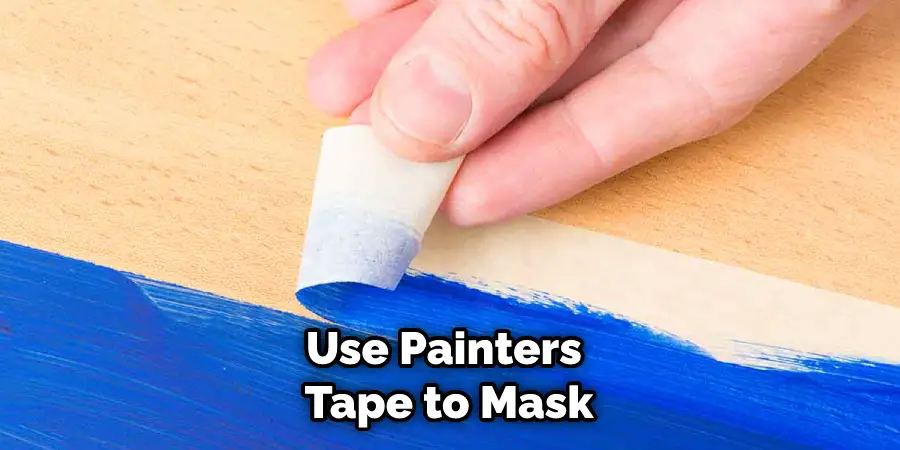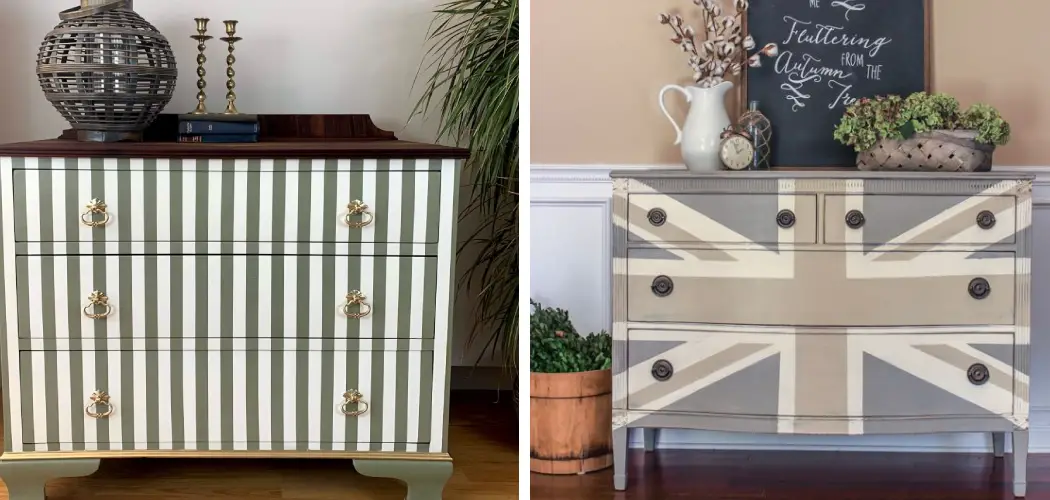Are you sprucing up your home decor this summer with a little DIY? If so, one of the hottest trends in furniture refinishing is painting stripes on pieces to give them an eye-catching new look. Whether it’s a nightstand, dresser, or armoire that caught your eye at the flea market – or even an aging piece that has been languishing in your attic gathering dust for years – taking on the task of adding stripes to layer and highlight their age-worn appeal can be daunting.

But don’t let fear stop you! With just some simple steps on how to paint stripes on furniture and these tips are more easily accomplished than ever before. Read on to learn how to paint perfect stripes every time!
Why Painting Stipes on Furniture is a Good Idea
Whether you love classic looks or a more eclectic style, stripes can be the perfect way to add visual interest to a furniture piece. Stripes of different colors, shades, and widths can provide lots of contrast and texture for an eye-catching look. Or, if you prefer a monochromatic palette, playing with various shades of one color – such as light and dark blue – can be just as striking.
No matter what colors or widths you choose, stripes help to give furniture pieces an updated look without having to paint the entire piece in one color. Stripes also help draw attention to specific areas of the furniture, such as the drawers or legs.
Things to Consider Before Painting
Before you dive in and start painting stripes, there are a few important things to consider:
- How big do you want the stripes? Will they be thin or thick? How about vertical or horizontal? How many colors will you use for your stripes?
- How will the surface of the piece affect the way the stripes will look? How do you want to prepare the surface for painting?
- How are you going to measure and mark out the stripes, so they are even and symmetrical?
- How will you use color-blocking techniques to ensure crisp, clean lines between each stripe and avoid bleeding into one another?
The answers to these questions will depend on what kind of look you are going for and the style of the piece. The more prepared you are, the better your results will be!
Required Items
You’ll need several materials and tools before you begin painting stripes on furniture.
- Primer or pre-paint conditioner
- Paint brushes
- Sandpaper and sanding block
- Ruler or measuring tape
- Chalk or painter’s tape
- Appropriate paint (latex or oil-based)
- Drop cloths
- Masking tape or frog tape
10 Tips on How to Paint Stripes on Furniture
Once you have all the items ready, it’s time to dive in and start painting stripes. Here is a step-by-step guide to help you get beautiful, perfect stripes every time:
1. Prepare the Surface
Prepare the furniture surface by sanding it down and wiping away any dust or debris. Clean the surface with a damp cloth and then prime it. A clean surface is key to good results.
2. Measure and Mark

Measure the size of stripes you want and use a leveler to mark even lines across the furniture. Use painter’s tape to outline your stripe pattern before you start painting. Marking out the stripes ahead of time will ensure that you get beautiful, even lines.
3. Apply Paint
Apply two coats of paint and make sure to let each one dry completely before moving on to the next step. Choose colors that complement each other for a balanced look.
4. Peel off the Tape
Once your paint is completely dry, carefully peel off the tape. If you notice any areas where the paint bled through, go over them with fine sandpaper to make sure they are smooth and even.
5. Seal It Up
Make sure to seal your furniture after stripping it so that it is protected from dirt and moisture. A clear coat of polyurethane or lacquer will do the trick. Sealing the paint will also give it a professional finish.
6. Line It Up

Once your furniture is sealed, you can use a ruler to measure and draw even lines along the edges of the stripes. This will help make sure that each stripe looks perfectly straight and even.
7. Let It Dry
Finally, let the furniture dry completely before using it. After that, you can sit back and admire your work! It is easy once you know the basics – just follow these steps for perfect results every time.
8. Clean up
Make sure to clean up your supplies after you have finished painting. Wipe away any excess paint and keep the area clean so that you can use it for future projects.
9. Practice Makes Perfect
When it comes to painting stripes on furniture, practice makes perfect. Try out various techniques, such as masking tape or freehand painting, to find out which method you like best.
10. Enjoy!
Most importantly, have fun with it and enjoy your newly painted furniture! It is an easy way to add a unique touch of style to any room or piece of furniture. With just a bit of time and effort, you can create a stunning accent piece that will be the focal point of your home.

With these tips, you should now have all the knowledge you need about how to paint stripes on furniture, So grab some supplies and get creative! You’ll be amazed at what you can achieve!
8 Take Care Tips for the Stripped Paint Furniture
1. Keep Them in the Shade
It is important to keep the stripped furniture in shaded areas as much as possible when painting stripes. This will help protect the paint from fading and warping due to sunlight exposure. It should also be kept away from high-traffic areas to prevent wear and tear.
2. Clean the Surface
Before applying paint, it’s important to make sure the surface of the stripped furniture is clean and free of dirt or dust. This can easily be done with a damp cloth or an all-purpose cleaner. Make sure that the surface is completely dry before beginning.
3. Mask Areas to Avoid

To create crisp, clean lines, use painter’s tape to mask off areas of the furniture that should not be painted. This will help keep the stripes even and neat and make it easier for you to achieve the desired pattern.
4. Keep them Dry
Once the stripes are painted, it’s important to keep them dry. Applying a sealant or varnish can help protect and extend the life of the stripes, however, regular dusting and cleaning are still necessary.
5. Monitor for Wear and Tear
Since striped furniture can be more prone to wear and tear than other types of furniture, it’s important to check the stripes regularly for signs of wear and tear. If any areas become worn or cracked, touch them up with a small brush and some paint as soon as possible.
6. Repair Any Damaged Areas
Should any parts of the furniture be damaged due to excessive wear and tear, it’s important to repair the area as soon as possible. This can be done by sanding down the damaged wood, applying a primer, and then repainting the stripes.
7. Choose the Right Paint
When painting stripes on furniture, it’s essential to choose high-quality paint that will hold up well over time. A satin or semi-gloss paint is ideal, as it will provide good coverage and won’t be too shiny.
8. Use the Right Tools
In order to create perfect stripes, it’s important to use the right tools for the job. A brush can be used when painting small areas, but a roller is better for larger surfaces. A level can also be used to make sure the stripes are straight.
It’s also a good idea to use painter’s tape to ensure crisp, even lines. All of these tools can help you achieve beautiful striped furniture that will look great for years to come.
What is the Best Paint for Furniture?
When it comes to painting furniture, you should always use high-quality paint that is specially formulated for use on furniture. These paints are generally more durable and will withstand wear and tear better over time. When choosing a paint color, it’s important to consider the existing décor in the room. It should also be easy to clean and free of any toxic chemicals. Acrylic, enamel, and lacquer are all good choices for furniture paint.
Conclusion
In conclusion, there is a lot that goes into creating beautifully painted furniture with stripes. Taking the time to prepare the surface of your piece by sanding and priming it will help guarantee an even final coat. Make sure you apply each stripe with a steady hand for smooth lines and don’t forget to use painter’s tape along edges for refined edges. Protect your freshly painted work by finishing with a clear sealant.
From the careful selection of color palettes to the secure masking techniques, painting stripes on furniture is an art form that anyone can master. With the right approach and detailed steps on how to paint stripes on furniture, you’ll be able to complete beautiful projects with effortless confidence!
About
Angela is the chief editor of Indoorense. She began her career as an interior designer before applying her strategic and creative passion to lifestyle and home.
She has close to 15 years of experience in creative writing and online content strategy for housekeeping and cleaning,home decorations as well as other efforts.
She loves her job and has the privilege of working with an extraordinary team. She lives with her husband, two sons, and daughter in Petersburg. When she’s not busy working she spent time with her family.

